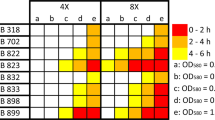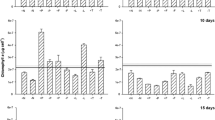Abstract
We report results of a study conducted to evaluate effects of ammonium, iron and temperature on microcystins (MC) and proteins content in cultures of a natural Microcystis aeruginosa population, concentrated from a field sample of San Roque reservoir (Córdoba – Argentina).
Based on a previous field study, we tested two temperatures (20 and 28 ∘C), two iron concentrations (1 μM and 10 μM) and two ammonium-nitrogen conditions (absence and 54 μM) in semi-continuous cultures.
Total MC (TMC = MC-LR + MC-RR) and protein content per cyanobacteria cell increased when Fe concentration was enlarged. However, the ratio TMC: protein was almost the same for both iron concentrations. Thus, a high level of iron enhances both protein and MC content in the same proportion.
TMC and protein content are significantly lowered in presence of 54 μM-N-ammonium. Additionally, the ratio TMC: protein is lowered by almost two folds in cultures having ammonium.
Increasing the temperature does not affect the protein content or TMC per cell. However, cultures carried out at 28 ∘C maintain the same MC-LR: MC-RR ratio during all the studied period, while cultures developed at 20 ∘C show that MC-RR content is increased by 82-fold after four growth cycles (20 days total), while MC-LR remain almost constant in the same time. As a result, in our case, different temperatures produce a significant change in the pattern of MC content but not in the content of TMC per cell.
The two-fold drop observed in MC content in presence of ammonium are within the range expected for physiological responses of cyanobacteria, raising questions on the probable inhibitory role of ammonium in MC production.
On the contrary, the 82-fold increase of MC-RR observed at 20 ∘C exceed the effects attributable to a cell physiological response, and could be better explained by an ecological shift from the starting genotype composition. Metagenomics, or similar molecular techniques, would provide the necessary tools to elucidate the ecological effect of temperature on cyanobacteria populations.
Similar content being viewed by others
References
Amé, M. V., Díaz, M. P. and Wunderlin, D. A.: 2003, ‘Occurrence of toxic cyanobacterial blooms in San Roque Dam (Córdoba – Argentina): A field and chemometric study’, Environ. Toxicol. 18, 192–201.
APHA (American Public Health Association), AWWA (American Water Works Association) and WEF (Water Environment Federation): 1998, Standard Methods for the Examination of Water and Wastewater 20th edition. L. S. Clesceri, A. H. Greenberg and A. D. Eaton (eds), American Public Health Association, Washington DC, 1025 pp.
Bickel, H. and Lyck, S.: 2001, ‘Importance of energy charge for microcystin production’, in I. Chorus (ed), Cyanotoxins, Springer, Berlin, pp. 133–141.
Böttcher, G., Chorus, I., Ewald, S., Hintze, T. and Walz, N.: 2001, ‘Light-limited growth and microcystin content of Planktothrix agardhii and Microcystis aeruginosa in turbidostats’, in I. Chorus (ed.), Cyanotoxins, Springer, Berlin, pp. 115–133.
Bradford, M.: 1976, ‘A rapid and sensitive method for the quantification of microgram quantities of protein utilizing the principle of protein-dye binding’, Anal. Biochem. 72, 248–254.
Carmichael, W. W.: 1996, ‘Toxic microcystis and the environment’, in M. F. Watanabe, K. Harada, W. W. Carmichael and H. Fujiki (eds.), Toxic Microcystis, CRC Press, Inc., Boca Raton, pp. 1–11.
Chorus, I.: 2001, ‘Cyanotoxin occurrence in freshwaters – a summary of survey results from different countries’, in I. Chorus (ed.), Cyanotoxins, Springer, Berlin, pp. 75–82.
Chorus, I., Niesel, V., Fastner, J., Wiedner, C., Nixdorf, B. and Lindenschmidt, K. E.: 2001, ‘Environmental factors and microcystin levels in waterbodies’, in I. Chorus (ed.), Cyanotoxins, Springer, Berlin, pp. 159–177.
Christiansen, G., Fastner, J., Erhard, M., Börner, T. and Dittmann, E.: 2003, ‘Microcystin biosynthesis in Planktothrix: Genes, evolution, and manipulation’, J. Bacteriol. 185, 564–572.
Codd, G. A. and Bell, S. G.: 1985, ‘Eutrophication and toxic cyanobacteria in freshwaters’, Water Pollut Control 84, 21–30.
Codd, G. A. and Ponn, G. K.: 1988, ‘Cyanobacterial toxins’, in J. G. Gallon and L. J. Rogers (eds), Proc. Phytochem. Soc. Eur. 28. Oxford University Press, Oxford, pp. 283–296.
Codd, G. A., Bell, S. G., Kaya, K., Ward, C. G., Beattie, K. A. and Metcalf, J. S.: 1999, ‘Cyanobacterial toxins, exposure routes and human health’, Eur. Journal Phycol. 34, 405–415.
Dittmann, E., Erhard, M., Tillet, D., Neilan, B. A., von Döhren, H. and Börner, T.: 2001, ‘Characterization of microcystin synthetase genes in Microcystis aeruginosa’, in I. Chorus (ed.), Cyanotoxins, Springer, Berlin, pp. 115–133.
Dorigo, U., Volatierb, L. and Humberta, J.-F.: 2005, ‘Molecular approaches to the assessment of biodiversity in aquatic microbial communities’, Water Res. 39, 2207–2218.
Fastner, J., Erhard, M., Carmichael, W. W., Sun, F., Rinehart, K. L., Rönicke, H. and Chorus, I.: 1999, ‘Characterization and diversity of Microcystins in natural blooms and strains of the genera Microcystis and Planktothrix from German freshwaters’, Arch. Hidrobiol. 2, 147–163.
Fastner, J., Erhard, M. and Neumann, U.: 2001, ‘Microcystin Variants in Microcystis and Planktothrix Dominated Field Samples’, in I. Chorus (ed.), Cyanotoxins, Springer, Berlin, pp. 148–152.
Herrero, A., Muro-Pastor, A. M. J. and Flores, E.: 2001, ‘Nitrogen control in cyanobacteria’, J. Bacteriol. 183(2), 411–425.
Hesse, K. and Kohl, J. G.: 2001, ‘Effects of light and nutrient supply on growth and microcystin content of different strains of Microcystis aeruginosa’, in I. Chorus (ed), Cyanotoxins, Springer, Berlin, pp. 104–115.
Kaebernick, M., Neilan, B. A., Börner, T. and Dittmann, E.: 2000, ‘Light and the transcriptional response of the microcystin biosynthesis gene cluster’, Appl. Environ. Microb. 66, 3387–3392.
Kotai, J.: 1972, ‘Instructions for preparation of modified Z8 for algae, B-11/69’, Norwegian Institute for Water Research Publication, Blinderan, Oslo, 5.
Kurmayer, R., Christiansen, G. and Chorus, I.: 2003, ‘The abundance of microcystin-producing genotypes correlates positively with colony size in Microcystis sp. and determines its microcystin net production in Lake Wannsee’, Appl. Environ. Microbiol. 69, 787–795.
Lawton, L., Marsalek, B., Padisák, J. and Chorus, I.: 1999, ‘Determination of cyanobacteria in the laboratory’, in I. Chorus and J. Bartram (eds), Toxic Cyanobacteria in Water. A Guide to Their Public Health Consequences, Monitoring and Management, E and FN Spon, London and New York, pp. 347–367.
Lyck, S., Gjølme, N. and Utkilen, H.: 1996, ‘Iron starvation increases toxicity of Microcystis aeruginosa CYA 228/1 (Chroococcales, Cyanophyceae)’, Phycologia 35(6 Suppl), 120–124.
Long, B. M., Jones G. J. and Orr, P. T.: 2001, ‘Cellular microcystin content in N-limited Microcystis aeruginosa can be predicted from growth rate’, Appl. Environ. Microbiol. 67, 278–283.
Meriluoto, J.: 1997, ‘Chromatography of microcystins’, Anal. Chim. Acta 352, 277–298.
Oh, H. M., Lee, S. J., Jang, M. H. and Yoon, B. D.: 2000, ‘Microcystin production by Microcystis aeruginosa in a phosphorus-limited chemostat’, Appl. Environ. Microbiol. 66, 176–179.
Orr, P. T. and Jones, G. J.: 1998, ‘Relationship between microcystin production and cell division rates in nitrogen-limited Microcystis aeruginosa cultures’, Limnol. Oceanogr. 43, 1604–1614.
Park, H. D., Iwami, C., Watanabe, M. F., Harada, K. I., Okino, T. and Hayashi, H.: 1998, ‘Temporal variabilities of the concentration of intra- and extracellular microcystin and toxic Microcystis species in a hypertrophic lake, Lake Suwa, Japan (1991–1994)’, Environ. Toxicol. Water Qual. 13, 61–72.
Pflugmacher, S., Codd, G. A. and Steinberg, C. E. W.: 1999, ‘Effects of the cyanobacterial toxin microcystin-LR on detoxication enzymes in aquatic plants’, Environ. Toxicol. 14, 111–115.
Pflugmacher, S. and Wiegand, C.: 2001, ‘Metabolism of microcystin-LR in aquatic organism’, in I. Chorus (ed.), Cyanotoxins, Springer, Berlin, pp. 257–260.
Rapala, J., Sivonen, K., Lyra, C. and Niemelä, S. C.: 1997, ‘Variation of Microcystins, cyanobacterial hepatotoxins, in Anabaena spp. as function of growth stimuli’, Appl. Environ. Microbiol. 63, 2206–2212.
Rapala, J. and Sivonen, K.: 1998, ‘Assessment of environmental conditions that favour hepatotoxic and neurtotoxic Anabaena spp. Strains in cultured under light-limitation at different temperatures’, Microbial. Ecol. 36, 181–192.
Rohrlack, T., Henning, M. and Kohl, J. G.: 2001, ‘Isolation and characterization of colony-forming Microcystis aerurinosa strains’, in I. Chorus (ed.), Cyanotoxins, Springer, Berlin, pp. 152–158.
Sivonen, K.: 1996, ‘Cyanobacterial toxins and toxin production’, Phycologia 35(6 supplement), 12–24.
Sivonen, K. and Jones, G.: 1999, ‘Cyanobacterial toxins’, in I. Chorus and J. Bartram (eds), Toxic Cyanobacteria in Water. A Guide to Their Public Health Consequences, Monitoring and Management, E and FN Spon, London and New York, pp. 41–111.
Utkilen, H. and Gjølme, N.: 1992, ‘Toxin production by Microcystis aeruginosa as a function of light in continuous cultures and its ecological significance’, Appl. Environ. Microbiol. 58, 1321–1325.
Utkilen, H. and Gjølme, N.: 1995, ‘Iron-stimulated toxin production in Microcystis aeruginosa’, Appl. Environ. Microb. 61, 797–800.
Watanabe, M. F.: 1996, ‘Production of microcystins’, in M. F. Watanabe, K. Harada, W. W. Carmichael and H. Fujiki (eds), Toxic Microcystis, CRC Press, Inc. Boca Raton, pp. 35–56.
Welker, M., Hoeg, S. and Steinberg, C.: 1999, ‘Hepatotoxic cyanobacteria in the shallow lake Müggelsee’, Hydrobiologia 408/409, 263–268.
Welker, M., Steinberg, C. and Jones, G.: 2001, ‘Release and persistence of microcystins in natural waters’, in I. Chorus (ed.), Cyanotoxins, Springer, Berlin, pp. 83–99.
Xie; L., Xie, P., Li, S., Tang, H. and Liu, H.: 2003, ‘The low TN:TP ratio, a cause or a result of Microcystis blooms?’, Water Res. 37, 2073–2080.
Author information
Authors and Affiliations
Corresponding author
Rights and permissions
About this article
Cite this article
Amé, M.V., Wunderlin, D.A. Effects of Iron, Ammonium and Temperature on Microcystin Content by a Natural Concentrated Microcystis Aeruginosa Population. Water Air Soil Pollut 168, 235–248 (2005). https://doi.org/10.1007/s11270-005-1774-8
Received:
Accepted:
Issue Date:
DOI: https://doi.org/10.1007/s11270-005-1774-8




